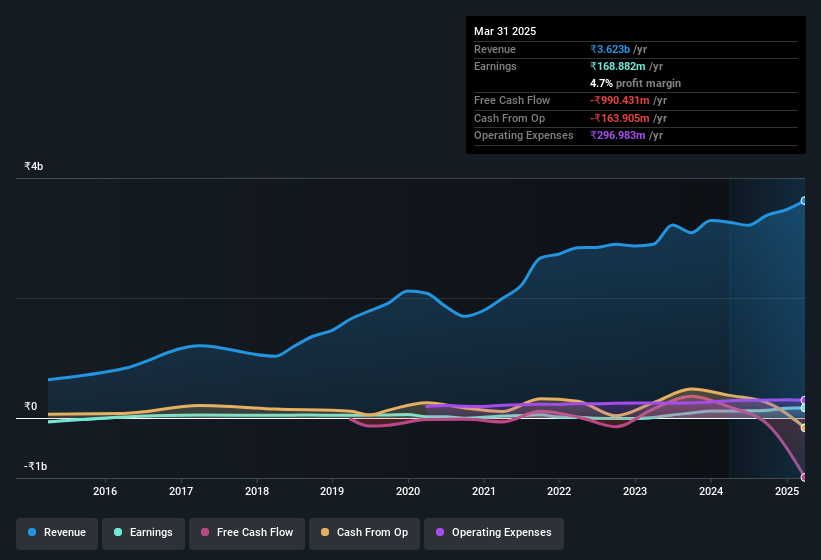Statutory Earnings May Not Be The Best Way To Understand Synergy Green Industries' (NSE:SGIL) True Position
Synergy Green Industries Limited (NSE:SGIL) recently released a strong earnings report, and the market responded by raising the share price. While the headline numbers were strong, we found some underlying problems once we started looking at what drove earnings.

A Closer Look At Synergy Green Industries' Earnings
As finance nerds would already know, the accrual ratio from cashflow is a key measure for assessing how well a company's free cash flow (FCF) matches its profit. The accrual ratio subtracts the FCF from the profit for a given period, and divides the result by the average operating assets of the company over that time. You could think of the accrual ratio from cashflow as the 'non-FCF profit ratio'.
As a result, a negative accrual ratio is a positive for the company, and a positive accrual ratio is a negative. While having an accrual ratio above zero is of little concern, we do think it's worth noting when a company has a relatively high accrual ratio. To quote a 2014 paper by Lewellen and Resutek, "firms with higher accruals tend to be less profitable in the future".
Synergy Green Industries has an accrual ratio of 0.71 for the year to March 2025. Statistically speaking, that's a real negative for future earnings. And indeed, during the period the company didn't produce any free cash flow whatsoever. Over the last year it actually had negative free cash flow of ₹990m, in contrast to the aforementioned profit of ₹168.9m. We saw that FCF was ₹184m a year ago though, so Synergy Green Industries has at least been able to generate positive FCF in the past. Notably, the company has issued new shares, thus diluting existing shareholders and reducing their share of future earnings. The good news for shareholders is that Synergy Green Industries' accrual ratio was much better last year, so this year's poor reading might simply be a case of a short term mismatch between profit and FCF. As a result, some shareholders may be looking for stronger cash conversion in the current year.
Note: we always recommend investors check balance sheet strength. Click here to be taken to our balance sheet analysis of Synergy Green Industries.
One essential aspect of assessing earnings quality is to look at how much a company is diluting shareholders. In fact, Synergy Green Industries increased the number of shares on issue by 10.0% over the last twelve months by issuing new shares. As a result, its net income is now split between a greater number of shares. To talk about net income, without noticing earnings per share, is to be distracted by the big numbers while ignoring the smaller numbers that talk to per share value. Check out Synergy Green Industries' historical EPS growth by clicking on this link.
How Is Dilution Impacting Synergy Green Industries' Earnings Per Share (EPS)?
Synergy Green Industries has improved its profit over the last three years, with an annualized gain of 1,082% in that time. In comparison, earnings per share only gained 1,002% over the same period. And at a glance the 46% gain in profit over the last year impresses. On the other hand, earnings per share are only up 36% in that time. So you can see that the dilution has had a bit of an impact on shareholders.
Changes in the share price do tend to reflect changes in earnings per share, in the long run. So Synergy Green Industries shareholders will want to see that EPS figure continue to increase. But on the other hand, we'd be far less excited to learn profit (but not EPS) was improving. For that reason, you could say that EPS is more important that net income in the long run, assuming the goal is to assess whether a company's share price might grow.
Our Take On Synergy Green Industries' Profit Performance
As it turns out, Synergy Green Industries couldn't match its profit with cashflow and its dilution means that earnings per share growth is lagging net income growth. Considering all this we'd argue Synergy Green Industries' profits probably give an overly generous impression of its sustainable level of profitability. With this in mind, we wouldn't consider investing in a stock unless we had a thorough understanding of the risks. Case in point: We've spotted 3 warning signs for Synergy Green Industries you should be mindful of and 2 of them are potentially serious.
In this article we've looked at a number of factors that can impair the utility of profit numbers, and we've come away cautious. But there are plenty of other ways to inform your opinion of a company. Some people consider a high return on equity to be a good sign of a quality business. So you may wish to see this free collection of companies boasting high return on equity, or this list of stocks with high insider ownership.
New: Manage All Your Stock Portfolios in One Place
We've created the ultimate portfolio companion for stock investors, and it's free.
• Connect an unlimited number of Portfolios and see your total in one currency
• Be alerted to new Warning Signs or Risks via email or mobile
• Track the Fair Value of your stocks
Have feedback on this article? Concerned about the content? Get in touch with us directly. Alternatively, email editorial-team (at) simplywallst.com.
This article by Simply Wall St is general in nature. We provide commentary based on historical data and analyst forecasts only using an unbiased methodology and our articles are not intended to be financial advice. It does not constitute a recommendation to buy or sell any stock, and does not take account of your objectives, or your financial situation. We aim to bring you long-term focused analysis driven by fundamental data. Note that our analysis may not factor in the latest price-sensitive company announcements or qualitative material. Simply Wall St has no position in any stocks mentioned.
About NSEI:SGIL
Synergy Green Industries
Engages in the manufacture and sale of wind turbine casting and other large precision castings in India.
Proven track record with imperfect balance sheet.
Similar Companies
Market Insights
Community Narratives



